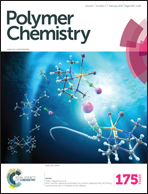Ultrathin free-standing polymer membranes with chemically responsive luminescence via consecutive photopolymerizations†
Abstract
A facile and general method for the preparation of chemically responsive polymer films is demonstrated. First, a crosslinked polymer precoating layer is created via self-initiated photografting and photopolymerization of ethylene glycol dimethacrylate on a self-assembled monolayer of a 3-(trimethoxysilyl)propylamine modified oxidized silicon wafer. The intact methacrylate functionalities are used to grow polymer chains by a second self-initiated photografting and photopolymerization of vinyl monomers to form polymer brushes on the crosslinked layer; thus a series of polymer membranes of PMMA, PDMAEMA and P4VP are obtained. The double-layered polymer membranes can be lifted off via hydrofluoric acid etching of the oxidized silicon layer to give integral free-standing polymer membranes. Kinetic studies revealed that the thickness of both the crosslinked precoating layer and the brush layer increased linearly as a function of the polymerization time before the reaction solutions got highly viscous. Furthermore, polyoxometalate Na9(EuW10O36) can be uniformly incorporated into the PDMAEMA membrane through electrostatic interactions to afford an acid/base gas-responsive luminescent hybrid film.


 Please wait while we load your content...
Please wait while we load your content...